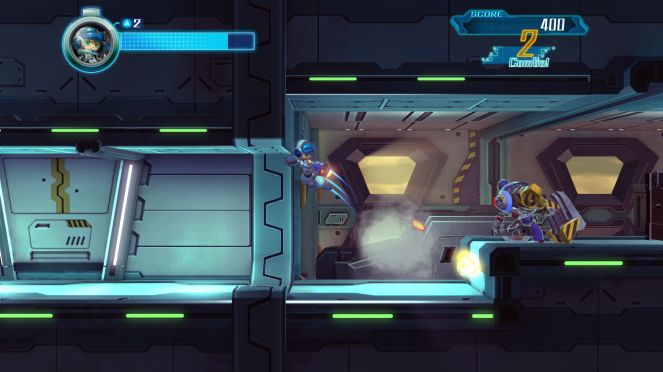
Mighty No. 9 never hid what it was going to be. The project, under direction from Japanese game developer Keiji Inafune, pitched itself as a spiritual successor to his own (sort of) Mega Man.
Unsurprising, then, is how hard the finished Mighty No. 9 leans on Mega Man. That was the intent. The shock then comes from the failure, Mighty No. 9 left reeling in a barely finished state – shoddy knock-off as opposed to genuine successor.
History repeats itself in unique ways. Circa 1993, publishing arm Data East issued Fighter’s History, an unremarkable tournament style martial arts fest – unremarkable aside from its penchant for cloning Capcom’s then hyper popular Street Fighter II. Capcom sued.
Fighter’s History starred Mizoguchi, a muscular brawler in gi pants and a headband who lofted fireballs from his hands. Street Fighter II’s Ryu had competition. Jean Pierre, Frenchman in military garb drifted toward the sharp-haired Guile. Ryoko, the chipper woman, mirrored Chun-Li’s own excitement. And Mastorious, Italian pro wrestler who would challenge Zangief for his title. A judge ruled against Capcom, concluding these elements, both of gameplay and designs, were obligatory for the genre.
Of note, Fighter’s History scored tepidly. Long running video game magazine EGM docked the Super Nintendo port for its derivatives and GamePro knocked it for being “unremarkable.” Everything said in 1993 applies to Mighty No. 9 in 2016.
Mega Man’s original storyline is aped in totality – rogue robots, scientists at a loss, and No. 9 the healthy hero ‘bot (sporting a cannon arm and helmet). His woman sidekick Call, covered by a red dress, carries the form of Mega Man’s Roll. Robot masters aren’t subtle either. Seismic catches rocks falling from the ceiling, identical in form to Gutsman from Mega Man’s maiden outing. Brandish, both in looks and narrative, copies the thematic tone of Proto Man, red dressing, yellow scarf, and all.
But it’s a front. Mighty No. 9 looks like Mega Man. It doesn’t move like Mega Man. Lost is a level of personality exuded by the iconic video game hero. Even under the limitations of 8-bit, Mega Man brandished a look of determination on his face as he charged forward. His mouth dropped open when taking a hit and he blasted his foes with visible confidence. This was evident in Mighty No. 9’s pitch – 9 shouts mid-stride as he fires his arm blaster toward an enemy. That animation, along with the hallmarks of Mega Man, do not exist in the finished game.
Although divergent in their genre, Fighter’s History and Mighty No. 9 inexplicably merge. Identifying markers and individuality drift away. It’s clear (in both cases) who copied who. Both share a certain listlessness in their designs, unable to capture the inherent charms and gameplay hooks. Fighter’s History lacked fluidity and satisfying combos, Mighty No. 9 lacks charm and energy. Inafune cannot recapture the magic of his own work, ignoring the crucial elements which allowed Mega Man to subsist for decades. At least Fighter’s History came from a different developer entirely.
The real lark is for those who Kickstarted their developer hero, someone they logically assumed could resurrect their favorite video game mascot. Instead, backers receive a sluggish B-level output, whimpering to a finish after months of delays. If Mighty No. 9 develops cautionary history, it’s that of Kickstarter trepidation – be wary, choose carefully. Promises are often break apart the same as Mighty No. 9.
1/5